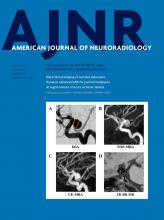Index by author
Kim, S.O.
- Head & NeckYou have accessA Scoring System for Prediction of Cervical Lymph Node Metastasis in Patients with Head and Neck Squamous Cell CarcinomaM.S. Chung, Y.J. Choi, S.O. Kim, Y.S. Lee, J.Y. Hong, J.H. Lee and J.H. BaekAmerican Journal of Neuroradiology June 2019, 40 (6) 1049-1054; DOI: https://doi.org/10.3174/ajnr.A6066
Kim, S.U.
- EDITOR'S CHOICEAdult BrainOpen AccessA Novel Collateral Imaging Method Derived from Time-Resolved Dynamic Contrast-Enhanced MR Angiography in Acute Ischemic Stroke: A Pilot StudyH.G. Roh, E.Y. Kim, I.S. Kim, H.J. Lee, J.J. Park, S.B. Lee, J.W. Choi, Y.S. Jeon, M. Park, S.U. Kim and H.J. KimAmerican Journal of Neuroradiology June 2019, 40 (6) 946-953; DOI: https://doi.org/10.3174/ajnr.A6068
The purpose of this study was to introduce a multiphase MRA collateral map derived from time-resolved dynamic contrast-enhanced MRA and to verify the value of the multiphase MRA collateral map in acute ischemic stroke by comparing it with the multiphase collateral imaging method (MRP collateral map) derived from dynamic susceptibility contrast-enhanced MR perfusion. The authors generated collateral maps using dynamic signals from dynamic contrast-enhanced MRA and DSC-MRP in 67 patients using a Matlab-based in-house program and graded the collateral scores of the multiphase MRA collateral map and the MRP collateral map independently. Interobserver reliabilities and intermethod agreement between both collateral maps for collateral grading were tested. The interobserver reliabilities forcollateral grading using multiphase MRA or MRP collateral maps were excellent. They conclude that the dynamic signals of dynamic contrast-enhanced MRA can generate multiphasecollateral images and show the possibility of the multiphase MRA collateral map as a useful collateral imaging method in acute ischemic stroke.
Kimberly, W.T.
- EDITOR'S CHOICEAdult BrainOpen AccessEnsemble of Convolutional Neural Networks Improves Automated Segmentation of Acute Ischemic Lesions Using Multiparametric Diffusion-Weighted MRIS. Winzeck, S.J.T. Mocking, R. Bezerra, M.J.R.J. Bouts, E.C. McIntosh, I. Diwan, P. Garg, A. Chutinet, W.T. Kimberly, W.A. Copen, P.W. Schaefer, H. Ay, A.B. Singhal, K. Kamnitsas, B. Glocker, A.G. Sorensen and O. WuAmerican Journal of Neuroradiology June 2019, 40 (6) 938-945; DOI: https://doi.org/10.3174/ajnr.A6077
Convolutional neural networks were trained on combinations of DWI, ADC, and low b-value-weighted images from 116 subjects. The performances of the networks (measured by the Dice score, sensitivity, and precision) were compared with one another and with ensembles of 5 networks. An ensemble of convolutional neural networks trained on DWI, ADC, and low b-value-weighted images produced the most accurate acute infarct segmentation over individual networks. Automated volumes correlated with manually measured volumes for the independent cohort.
Kimura, Yuiko
- PediatricsOpen AccessRadiologic and Pathologic Features of the Transmantle Sign in Focal Cortical Dysplasia: The T1 Signal Is Useful for Differentiating SubtypesYukio Kimura, A. Shioya, Y. Saito, Y. Oitani, Y. Shigemoto, E. Morimoto, F. Suzuki, N. Ikegaya, Yuiko Kimura, K. Iijima, Y. Takayama, M. Iwasaki, M. Sasaki and N. SatoAmerican Journal of Neuroradiology June 2019, 40 (6) 1060-1066; DOI: https://doi.org/10.3174/ajnr.A6067
Kimura, Yukio
- PediatricsOpen AccessRadiologic and Pathologic Features of the Transmantle Sign in Focal Cortical Dysplasia: The T1 Signal Is Useful for Differentiating SubtypesYukio Kimura, A. Shioya, Y. Saito, Y. Oitani, Y. Shigemoto, E. Morimoto, F. Suzuki, N. Ikegaya, Yuiko Kimura, K. Iijima, Y. Takayama, M. Iwasaki, M. Sasaki and N. SatoAmerican Journal of Neuroradiology June 2019, 40 (6) 1060-1066; DOI: https://doi.org/10.3174/ajnr.A6067
Kotsenas, A.L.
- You have accessThe Continued Rise in Professional Use of Social Media at Scientific Meetings: An Analysis of Twitter Use during the ASNR 2018 Annual MeetingG. D'Anna, M.M. Chen, J.L. McCarty, A. Radmanesh and A.L. KotsenasAmerican Journal of Neuroradiology June 2019, 40 (6) 935-937; DOI: https://doi.org/10.3174/ajnr.A6064
Kovanlikaya, I.
- Adult BrainOpen AccessQuantitative Susceptibility Mapping of Time-Dependent Susceptibility Changes in Multiple Sclerosis LesionsS. Zhang, T.D. Nguyen, S.M. Hurtado Rúa, U.W. Kaunzner, S. Pandya, I. Kovanlikaya, P. Spincemaille, Y. Wang and S.A. GauthierAmerican Journal of Neuroradiology June 2019, 40 (6) 987-993; DOI: https://doi.org/10.3174/ajnr.A6071
Kumar, S.
- Adult BrainOpen AccessBaseline and Evolutionary Radiologic Features in Sporadic, Hemorrhagic Brain Cavernous MalformationsK.D. Flemming, S. Kumar, G. Lanzino and W. BrinjikjiAmerican Journal of Neuroradiology June 2019, 40 (6) 967-972; DOI: https://doi.org/10.3174/ajnr.A6076
Kyheng, M.
- FELLOWS' JOURNAL CLUBNeurointerventionYou have accessFirst-Line Sofia Aspiration Thrombectomy Approach within the Endovascular Treatment of Ischemic Stroke Multicentric Registry: Efficacy, Safety, and Predictive Factors of SuccessG. Marnat, X. Barreau, L. Detraz, R. Bourcier, B. Gory, A. Sgreccia, F. Gariel, J. Berge, P. Menegon, M. Kyheng, J. Labreuche, A. Consoli, R. Blanc and B. Lapergue on behalf of the ETIS InvestigatorsAmerican Journal of Neuroradiology June 2019, 40 (6) 1006-1012; DOI: https://doi.org/10.3174/ajnr.A6074
The authors performed a retrospective analysis of the prospectively maintained Endovascular Treatment of Ischemic Stroke multicentric registry. Data from consecutive patients who benefited from thrombectomy with a first-line Sofia approach between January 2013 and April 2018 were studied. We excluded other first-line approaches (stent retriever or combined aspiration and stent retriever) and extracranial occlusions. During the study period, 296 patients were treated. Mean age and initial NIHSS score were, respectively, 69.5 years and 16. Successful reperfusion, defined by the modified TICI 2b/3, was obtained in 86.1%. Complete reperfusion (modified TICI 3) was obtained in 41.2%. A first-pass effect was achieved in 24.2%. A rescue stent retriever approach was required in 29.7%. The first-line contact aspiration approach appeared safe and efficient with Sofia catheters. These devices achieved very high reperfusion rates with a low requirement for stent retriever rescue therapy, especially for M1 occlusions.








